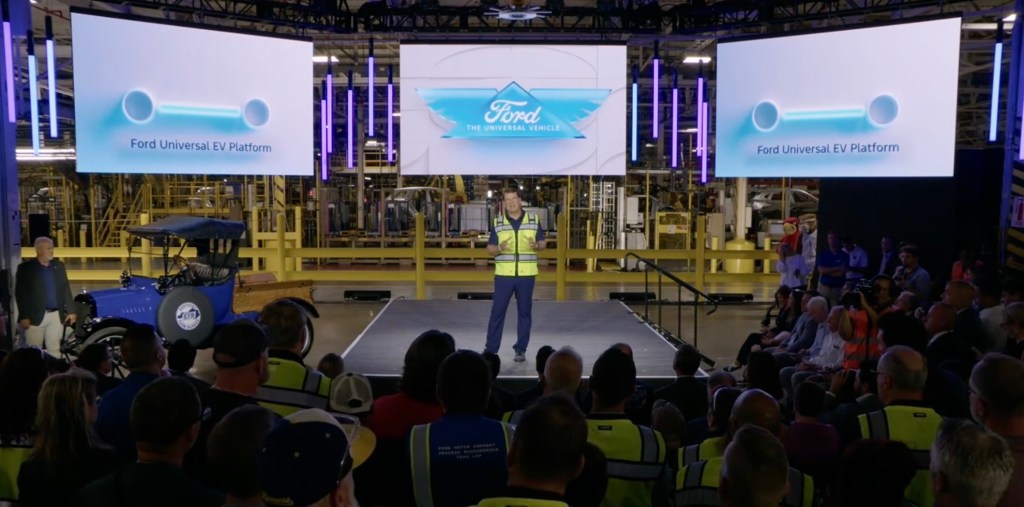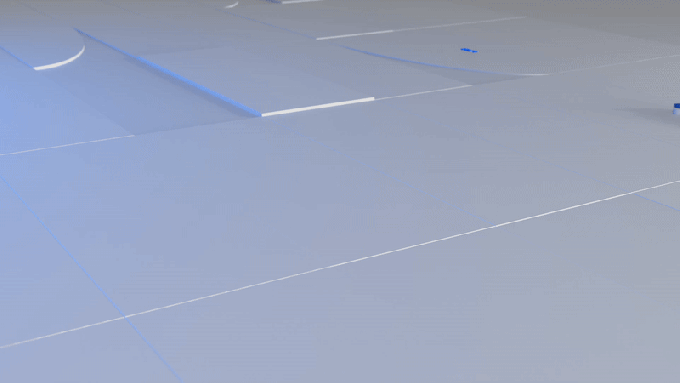
Image Credits:Ford/screenshot
Ford said Monday it will invest $2 billion to transform its Louisville Assembly Plant into a factory capable of making a new generation of affordable EVs, starting with a mid-sized pickup truck with a base price of $30,000 that is slated to launch in 2027.
This is not a standard factory upgrade. To reduce the cost of manufacturing, Ford has upended the moving assembly line system launched by its founder Henry Ford more than 112 years ago.
The automaker’s willingness to change the century-old system that made Ford a household name reflects the high-stakes juggling act of selling a line of affordable electric vehicles that could be made in the United States faster, more efficiently, and with fewer parts all while preserving profit margins. And as Ford’s chief EV, digital, and design officer Doug Field noted Monday it’s not just about driving down individual costs down, but a change that will allow the automaker to compete with China.
Ford CEO Jim Farley described the new production system, line of EVs, and $2 billion investment as a bet.
“There are no guarantees with this project,” he said during an event live streamed from the Kentucky plant. “We’re doing so many new things I can’t tell you with 100% uncertainty that this will all go just right, it is a bet. There is risk.”
That bet began several years ago with skunkworks team of about 500 people in California — led by former Tesla executive Alan Clarke and filled with talent from companies like Tesla, Rivian, Apple, and Lucid Motors. The team, which is split between Palo Alto and a new office in Long Beach, developed the new production system and underlying vehicle platform that will be used in the Louisville factory.
The end result is what Ford calls the “universal production system,” which changes its single conveyor line into a three-branched assembly tree. Ford has also developed a universal EV platform that will use lithium iron phosphate batteries using tech licensed from China’s CATL and manufactured at its new $3 billion BlueOval Battery Park factory in Michigan. That factory, which is expected to come online in 2026, will employ 1,700 hourly workers.
Tech and VC heavyweights join the Disrupt 2025 agenda
Netflix, ElevenLabs, Wayve, Sequoia Capital, Elad Gil — just a few of the heavy hitters joining the Disrupt 2025 agenda. They’re here to deliver the insights that fuel startup growth and sharpen your edge. Don’t miss the 20th anniversary of TechCrunch Disrupt, and a chance to learn from the top voices in tech — grab your ticket now and save up to $600+ before prices rise.
Tech and VC heavyweights join the Disrupt 2025 agenda
Netflix, ElevenLabs, Wayve, Sequoia Capital — just a few of the heavy hitters joining the Disrupt 2025 agenda. They’re here to deliver the insights that fuel startup growth and sharpen your edge. Don’t miss the 20th anniversary of TechCrunch Disrupt, and a chance to learn from the top voices in tech — grab your ticket now and save up to $675 before prices rise.
The new EV platform will consist of large single-piece aluminum unicastings that uses far fewer parts and will allow the front and rear of the vehicle to be assembled separately on two of the branches. The third branch is perhaps most notable; this is where the structural battery will be assembled with seats, consoles, and carpeting. The three components will come together at the end of the line to form the vehicle.
Unlike a traditional assembly line, where the workers move along adding the wire harness and other parts to the frame, the EV platform will consist of three kits. Within that kit, all fasteners, scanners and power tools required for the job are included – and in the correct orientation for use, according to Ford.

The EV platform will use 20% fewer parts than a typical vehicle and will be produced 15% faster, the company said.
“I’ve certainly never seen anything in the public domain that looks anything like this,” Clarke told TechCrunch in an interview ahead of the launch. “And I think that a manufacturing expert would look at this, and especially if they’ve been in the automotive industry for a few decades, would sort of scoff at it and say, ‘why would you do it this way?’”
Clarke is convinced that once manufacturing experts see how quickly a vehicle can go from start to finish, others will attempt to emulate this.
The new format and accompanying EV platform will change how the Louisville factory operates and reduce the number of workers employed there. The transformation will likely ripple through the broader supply chain as well. Ultimately, Clarke says, this will preserve American jobs.
Ford employs about 2,808 hourly workers at its Louisville assembly plant, which makes the Ford Escape and Lincoln Cosair. Production of those two vehicles will continue at the plant through the end of this year, before Ford begins retooling the factory and switching to the new family of EVs. Eventually, the plant will support 2,200 hourly workers. A Ford spokesperson said the automaker has offered a special retirement incentive program for others.
A reduction in workers and a “significant” increase in automation might typically prompt protests from the United Auto Workers. But Clarke says Ford worked with the UAW closely from the beginning and that there is “buy in.”
“The teams are really excited about what’s coming because they know that we have to be competitive and we have to make money from this project for jobs to stay in America,” he said, later adding, “This isn’t really, you know, optional.”

-
 C114 Communication Network
C114 Communication Network -
 Communication Home
Communication Home


